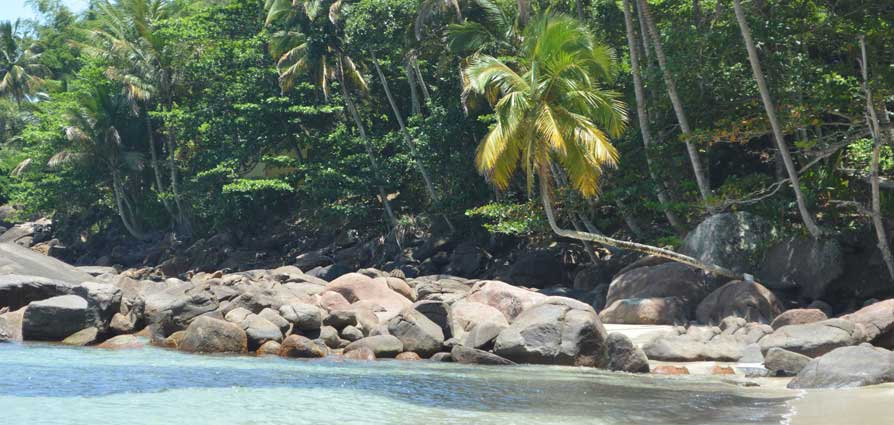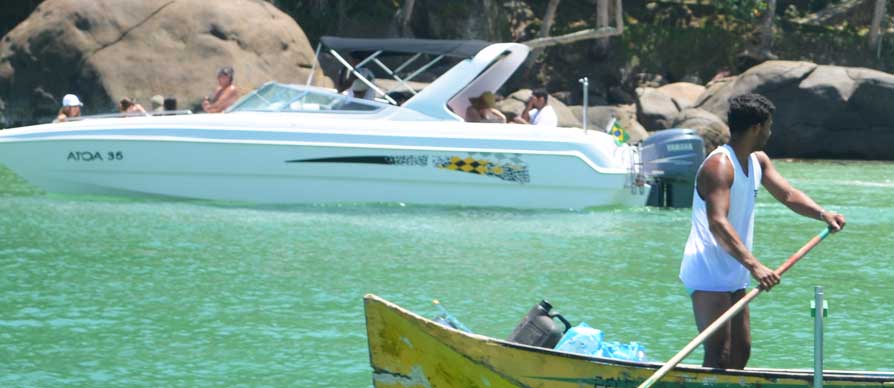Ilha Grande – “the undiscovered Paradise”
Ilha Grande has a colorful history of slaves and pirates and legends of the forgotten pirate treasures. Today, this paradiseisland can offer much of what we could wish for us tourists. Nice weather all year around, great for diving and snorkelling, nice people, jungle walks, good food and more than one hundred beaches to visit! You feel like Robinson Cruse when you have left Angra dos Reisbehind you and Ilha Grande’s high peaks shows up in the horizon.

Ilha Grande History
Ilha Grande was discovered in 1502 and was then inhabited by Indians “Tupinamba”. Tupinamba called the island Ipau Guass, meaning the big island. Another tribe, Goianaz, called the island Poro or Ipau Pora, which means the beautiful and wonderful island. The Indians used the island as a home for the older people because they felt that there were no dangerous animals on the island. For a long time after the discovery of Ilha Grande housed French, English and Dutch pirates here. The island was also used as an island to trade slaves and later as a labor colony for prisoners. In the 1700s started a long war between the Portuguese, French and Indians which delayed colonization by about 150 years. In the 1800s started the first colonists, peasants and slaves come to the island. Then came the fishermen who built the first villages.
Here was formerly a prison until 1994 and it is precisely for this that Ilha Grande is known for. Thanks to the prison, there was this village where people lived and worked. The closure of the prison changed the lives of Ilha Grande, before the people had not wanted to visit the island for the fear of the escaped prisoners. Paradoxically, it was precisely the prison’s existence that managed to preserve the island so well.Now the village only have a few people living here. There is a small shop which sells basic food and few domestic products. There are no hotels and camping are prohibited.
Igreja de Santana
This is Ilha Grande first real village & the church is one of the most important religious monuments in Ilha Grande. It is situated on a hill nicely nestled among lush trees on a small peninsula. The church was built in 1796 and is well preserved on the outside but it is unfortunately not allowed to enter. Here is cultivated in the past bananas, coffee and sugar cane went to hamstaden Angra dos Reis. You can go to this small village by private boat or via the Blue Lagoon excursion.

Facts about Ilha Grande, Brasil
Ilha Grande belongs to the city of Angra dos Reis, which is located on the mainland in the state of Rio de Janeiro. The island is separated from the South American continent through a two kilometer long and 25 feet deep channel. Ilha Grande is about 190 sq km high and the highest point is Pico da Pedra D’Agua (1035 m) and Pico do Papagaio (986 m). Apart from military and municipal communications, no vehicles are allowed. The climate here is tropical, hot and humid with regular rain periods. The temperature in summer is 30 – 40 ° C and in winter about 18 – 24 ° C. There are about 6 000 inhabitants on the island and the majority of them live in Vila do Abraão, where many ferries/boats arrive from the mainland every day. The most common transportation on the island is by boat and you can go with them to get to anyone of the one hundred beaches. If you are looking for more entertainment you can visit one of the beaches close to Abraão wherw you can take a diving course, go canoeing, fishing, etc.
Beaches and nature
There are more than one hundred beaches to explore and enjoy. The most famous is Lopes Mendes and it is ideal for surfing. Ilha Grande is a perfect place for all diving enthusiasts and those who love nature. The island’s south-western part is a nature reserve where you can enjoy nature’s rich variety of birds, butterflies and other animals. Ilha Grande offers a lot of nice walks (trekkings) as a large part of the island is covered by a magnificent rainforest, which shows off a variety of butterflies, birds, flowers and other exotic plants. If you want a real adventure you should climb up the peak of Pico da Pedra dÁgua (1035) or Pico do Papagaio (986 m above sea level).

Abraão
Abraão has built an infrastructure to receive tourists. The village has hotels, restaurants, bars, small markets, pharmacies, medical center, post office and rental of scuba diving, boat and fishing equipment. You can also rent a Taxi boat on the beach.You can also choose to go with one of the boats that go to the beaches around the island. Otherwise, all the paths through the rainforest across the island leads to the beaches, waterfalls and historic monuments.
In the evening Ilha Grande offers several restaurants serving everything from typical Brazilian Churrasco and seafood. Grilled fish with names you can hardly say, shrimp in “bratwurst-size” served with a nice wine, the traditional drink “Caipirinha” or an ice cold “Chopper” (beer). Those of you who want the heavy night life have to go to the mainland, because here is a “quiet” place with small bars, swinging music and spontaneous dancing people.
ATTENTION: The island has no cashmachine, bank or possibility to change money. Most of the restaurants and souvernirshops accept creditcards. But “Cash is KING”





